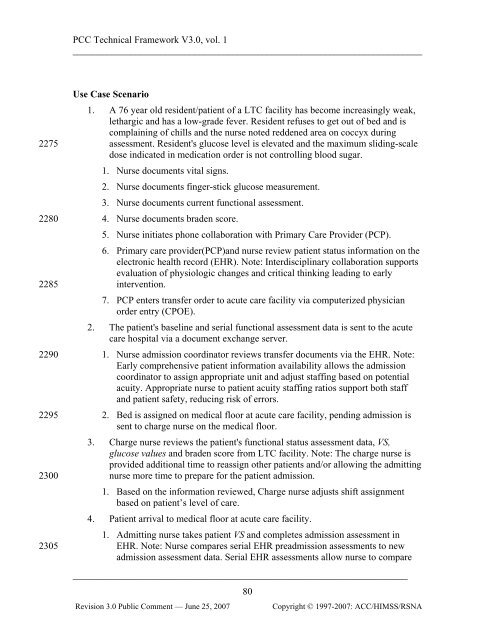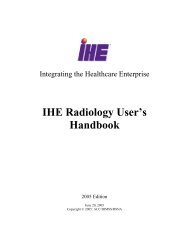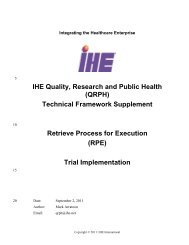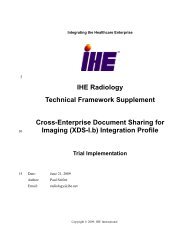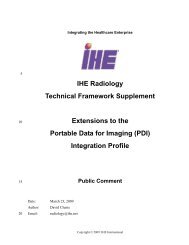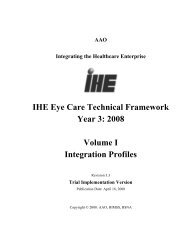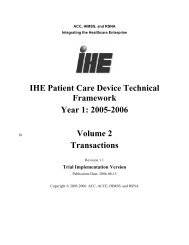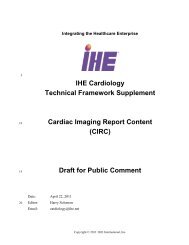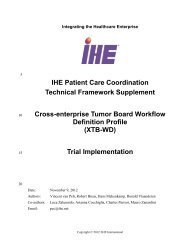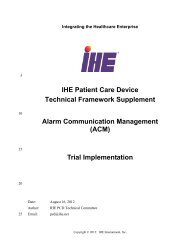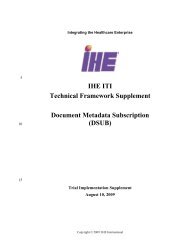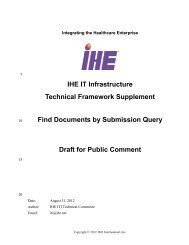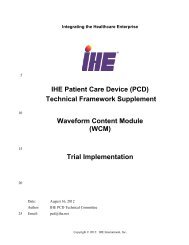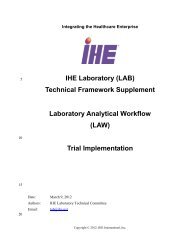IHE Patient Care Coordination Technical Framework Vol I
IHE Patient Care Coordination Technical Framework Vol I
IHE Patient Care Coordination Technical Framework Vol I
You also want an ePaper? Increase the reach of your titles
YUMPU automatically turns print PDFs into web optimized ePapers that Google loves.
PCC <strong>Technical</strong> <strong>Framework</strong> V3.0, vol. 1<br />
________________________________________________________________________<br />
2275<br />
2280<br />
2285<br />
2290<br />
2295<br />
2300<br />
2305<br />
Use Case Scenario<br />
1. A 76 year old resident/patient of a LTC facility has become increasingly weak,<br />
lethargic and has a low-grade fever. Resident refuses to get out of bed and is<br />
complaining of chills and the nurse noted reddened area on coccyx during<br />
assessment. Resident's glucose level is elevated and the maximum sliding-scale<br />
dose indicated in medication order is not controlling blood sugar.<br />
1. Nurse documents vital signs.<br />
2. Nurse documents finger-stick glucose measurement.<br />
3. Nurse documents current functional assessment.<br />
4. Nurse documents braden score.<br />
5. Nurse initiates phone collaboration with Primary <strong>Care</strong> Provider (PCP).<br />
6. Primary care provider(PCP)and nurse review patient status information on the<br />
electronic health record (EHR). Note: Interdisciplinary collaboration supports<br />
evaluation of physiologic changes and critical thinking leading to early<br />
intervention.<br />
7. PCP enters transfer order to acute care facility via computerized physician<br />
order entry (CPOE).<br />
2. The patient's baseline and serial functional assessment data is sent to the acute<br />
care hospital via a document exchange server.<br />
1. Nurse admission coordinator reviews transfer documents via the EHR. Note:<br />
Early comprehensive patient information availability allows the admission<br />
coordinator to assign appropriate unit and adjust staffing based on potential<br />
acuity. Appropriate nurse to patient acuity staffing ratios support both staff<br />
and patient safety, reducing risk of errors.<br />
2. Bed is assigned on medical floor at acute care facility, pending admission is<br />
sent to charge nurse on the medical floor.<br />
3. Charge nurse reviews the patient's functional status assessment data, VS,<br />
glucose values and braden score from LTC facility. Note: The charge nurse is<br />
provided additional time to reassign other patients and/or allowing the admitting<br />
nurse more time to prepare for the patient admission.<br />
1. Based on the information reviewed, Charge nurse adjusts shift assignment<br />
based on patient’s level of care.<br />
4. <strong>Patient</strong> arrival to medical floor at acute care facility.<br />
1. Admitting nurse takes patient VS and completes admission assessment in<br />
EHR. Note: Nurse compares serial EHR preadmission assessments to new<br />
admission assessment data. Serial EHR assessments allow nurse to compare<br />
_____________________________________________________________________<br />
Revision 3.0 Public Comment — June 25, 2007<br />
80<br />
Copyright © 1997-2007: ACC/HIMSS/RSNA


